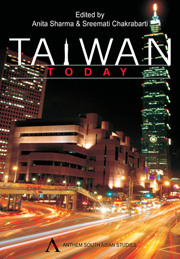Book contents
- Frontmatter
- Contents
- Acknowledgements
- Contributors to this Volume
- Acronyms and Abbreviations
- Foreword
- Introduction
- 1 Who are We? Identity in Transition
- 2 Taiwan: Yearning for an Identity
- 3 The Implications of Direct Flights: Beijing in Taiwanese Politics
- 4 Kuomintang, Democratization and the One-China Principle
- 5 The Deepening and Consolidation of Democracy in Taiwan
- 6 India and Taiwan: Bolstering Complementarity in Information Technology
- 7 Asian Regional Economic Integration and Taiwan–India Economic Relations
- 8 The Taiwan Factor in Sino–Indian Relations
- 9 Japan's Triumphant Diplomacy in Taiwan in 1874
- 10 A Study of the Cultural and Educational Exchanges between Taiwan and India, 1995–2006
- 11 Between Two Worlds: A Survey of Education in Taiwan
- 12 Female Immigrants, Social Capital and Public Sphere in Taiwan
- 13 Information Technology and Gender: Taiwan and India
- 14 Tzu Chi: A Case Study of Engaged Buddhism in Taiwan
- 15 Master Hsing Yun of Fo Guang Shan and the Development of Humanistic Buddhism
- 16 The Heritage and Innovation of Chan Paintings in Taiwan
- 17 Taiwan in World Architecture: A Historical Perspective
- Afterword
1 - Who are We? Identity in Transition
Published online by Cambridge University Press: 05 March 2012
- Frontmatter
- Contents
- Acknowledgements
- Contributors to this Volume
- Acronyms and Abbreviations
- Foreword
- Introduction
- 1 Who are We? Identity in Transition
- 2 Taiwan: Yearning for an Identity
- 3 The Implications of Direct Flights: Beijing in Taiwanese Politics
- 4 Kuomintang, Democratization and the One-China Principle
- 5 The Deepening and Consolidation of Democracy in Taiwan
- 6 India and Taiwan: Bolstering Complementarity in Information Technology
- 7 Asian Regional Economic Integration and Taiwan–India Economic Relations
- 8 The Taiwan Factor in Sino–Indian Relations
- 9 Japan's Triumphant Diplomacy in Taiwan in 1874
- 10 A Study of the Cultural and Educational Exchanges between Taiwan and India, 1995–2006
- 11 Between Two Worlds: A Survey of Education in Taiwan
- 12 Female Immigrants, Social Capital and Public Sphere in Taiwan
- 13 Information Technology and Gender: Taiwan and India
- 14 Tzu Chi: A Case Study of Engaged Buddhism in Taiwan
- 15 Master Hsing Yun of Fo Guang Shan and the Development of Humanistic Buddhism
- 16 The Heritage and Innovation of Chan Paintings in Taiwan
- 17 Taiwan in World Architecture: A Historical Perspective
- Afterword
Summary
INTRODUCTION
One of the biggest social transformations in Taiwan in the last 15 years is the change of the personal identity. Today's opinion poll revealed that people who identified themselves as: i) exclusively Taiwanese was about 60 per cent, ii) exclusively Chinese was about 5 per cent and iii) people who thought they were both Taiwanese and Chinese was about 35 per cent. In 1992, people who identified themselves as: i) exclusively Taiwanese was about 17 per cent, ii) exclusively Chinese was about 26 per cent and iii) people who thought they were both Taiwanese and Chinese was about 49 per cent. The change is certainly dramatic. Since this glacial change in personal-political identification happened during the period of Taiwan's democratization, many sociologists believe this is one of the many offspring of democratization.
This questionnaire sometimes makes cultural and national identity indistinguishable. Surveyees were asked if they were Taiwanese or Chinese. The third option was provided when asked by the surveyees.
DEMOCRATIZATION AND THE CHANGING IDENTITY
To understand the identity change and its relationship with democratization, one has to consider the political environment in Taiwan before democratization. Under Chiang Kai-Shek and Chiang Ching-Kuo's Kuomintang (KMT), ruling period from 1949 to 1988, anything resembling Taiwan was ruled as politically incorrect. The mandatory education system also indoctrinated the Chinese identity into the population.
- Type
- Chapter
- Information
- Taiwan Today , pp. 6 - 12Publisher: Anthem PressPrint publication year: 2010



